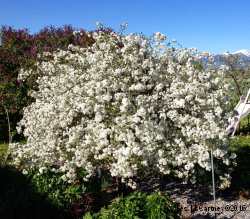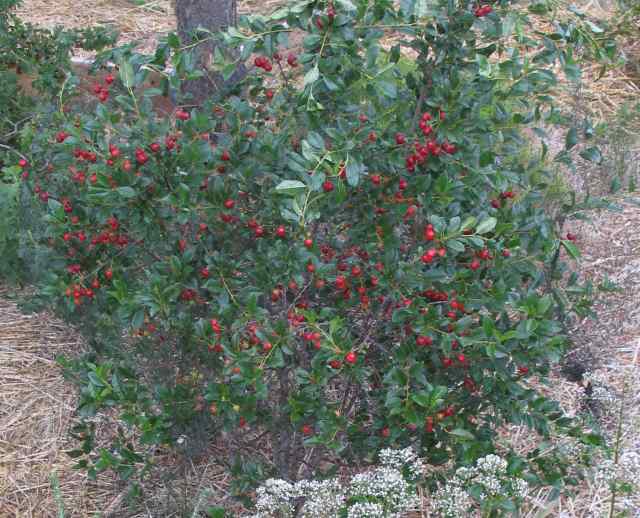
7 year old Carmine Jewel at Bozeman, MT. Grass kept away, fertilized with manure.
Tart Cherry Benefits
6 benefits - NDTV Food
1 TBSP 2x/day for Arthritis
Growing Cherries
Dwarf sour cherries prefer well-drained, sandy loam or loam soils, with a pH between 6.5 and 8.0. It is very important to keep perrenial weeds away from them as they stunt the trees' growth. Organic matter level between 2-3% is very important if you have clay or sandy soil. They do well under mulch. Water them a few times deeply to get them established. Here is one customer's story from Iowa, a visit to a cherry orchard in Saskatchewan, and an interview with a cherry picker at our orchard in Minnesota.
Size of full grown dwarf sour cherries is dependent on several factors. While listed at 6 1/2 feet tall in zone 2 in Canada, they can reach 12 feet in height in zone 4. Keeping encroaching grass and weeds away is also critical, as is appropriate moisture. Cherries do not like wet feet, but thrive with consistent watering especially the first three years. Pruning excess growth from the center of the bushes in late winter/early spring is also beneficial. Michigan State U affirms modest pruning can be done post-harvest on mature trees that have filled their space.
Ripening sequence in Saskatoon, SK (zone 2):
-Carmine Jewel (late July)
-Juliet
-Crimson Passion
-Romeo
-Evans Bali
-Lutowka
Peak bloom times in 2015 zone 3a:
- Juliet - May 15
- Romeo - May 20
- Carmine Jewel - May 21
- Cupid - May 23
More info: VARIATIONS IN NEW AND EXISTING U of S Sour Cherries, ADF report March 2011
U Mich Picture Table of Fruit Freeze Damage Thresholds
Renewal Pruning
growingfruit.org" reports one of Dr. Bob Bor's emails dated 7/1/14:: "For best longevity one should grow the cherries as bushes with multiple trunks. Using renewal thinning you should get rid of a trunk or two every year or two to allow new ones to form or let suckers in the row come up to replace them. Our original seedling rows are 22 years old and are still alive and fairly healthy. On a severe -50C winter, we didn't lose trees but we lost the oldest trunks of most trees. Specifically it was those branches that had born fruit for many years and were hardly making any growth. Perhaps a trunk should be removed somewhere around 7 years old? Maybe 10? I'd think the bushes could go on for many decades."
Harvesting
Hand picking
Over the row trial at MSU on other tart cherries
Extreme climate testimony
The cherry trees I have ordered in the past are doing great. This past year we were able to put up cherry jam. That may not sound like a a big accomplishment but for us it is. I live in New Mexico at high altitude, 7300 feet, and we get late frosts all the time. I have had fruit trees planted for the last 10 years and this is the first time I have had fruit of any kind except currants and grapes. Even though we are listed as zone 5B, the average last frost here is June 3rd. The cherries were blooming into June. I would have had cherries the previous year but it went down to 22 on June 16th. I planted one of the cherries in a hoop house to see if it would grow better there. I grew much faster and is twice the height of the ones outside. However, it blossoms too early and gets frosted. I am moving it outside this year. Below is a picture of one of the cherries netted to keep off the birds.
-Peter

History of U of S cherries
2019 Award
Tarts with a touch of romance - Good Fruit Grower Aug 2018
Cupid pits too large for tart cherry pitters.
Wowza originated at the U of S, called something like "Big Red" for its interesting, oblong shape and good taste, but not as productive as the other varieties (Dr. Bob Bors, MSU webinar 4/17/20)
How to plant your own cherry seeds
BHG
Favorite Recipes
Cherry Date Nut bars (sugar free)
From Saskatchewan, Canada - Shifting Roots Recipes:
How to Harvest & Preserve Sour Cherries including Cherry Jam
No Churn Cherry Cheesecake Ice Cream
Cherry Jelly
|
